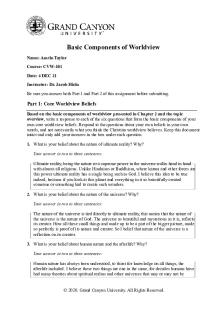Eight essential components of communication. PDF

| Title | Eight essential components of communication. |
|---|---|
| Course | Business Communications |
| Institution | University of the People |
| Pages | 2 |
| File Size | 44.4 KB |
| File Type | |
| Total Downloads | 34 |
| Total Views | 136 |
Summary
Eight essential components of communication....
Description
No individual, group or organization can exist without sharing meaning among its members. The communication process is the only way that people use to convey information and ideas, therefore communication must include both the transfer and the understanding of the meaning.The eight essential components of communication are defined as follows: A source is a place of origin, a thing from which something originates. It imagines, creates and sends the message. (Mc Lean, Scott (2010) ). For example, historical sources can be found in a document, picture, an object or television program. There can be a historical primary and secondary source, whereby the primary source originates from the past like a piece of pottery and a secondary source might be a book about history. A message is a physical product of the sender's encoding. When we speak, the speech is the message and when we gesture the movements of our arms and the expressions in our faces are the messages. A channel is a medium through which the message travels. It can be a formal channel which is established by the organization and transmits messages relate to the professional activities of members such as blogs, emails or text messages or it can be an informal channel which is spontaneous and emerge as a response to individual choices such as speeches, telephone conversations or voicemail messages. (Mc Lean, Scott (2010) ) A receiver is a person to whom the message is directed to. The receiver translates the message into an understandable form and must use the five senses to interpret the message. A feedback is where they check how successful one has been in transferring the message as the originally intended. It determines whether or not understanding has been achieved. An environment is an encompassment where messages are sent and received. It can be a furniture in the room, therefore the room is an environment. It's an atmosphere, climate or background. A context is where communication interaction involves the setting, scene, and expectations of the individuals involved. A place within which something happens. A background, framework or occurrence. Interference is the communication barrier that distorts the clarity of the message. It might be cultural differences, semantic differences or information workload. If one of these elements is taken out of the process, it might lead to the success or failure of the organization. For example, if interference is taken away, the organization might succeed because most communication barriers (noise) are the ones which cause conflicts in many organizations. When the participants or employees in an organization rely on one language without native tongue there will be no semantic noise within the individuals. If perfect communication existed it would occur when a thought or idea was transmitted to the receiver perceived it exactly the same mental picture from the source.
Reference
Mc Lean, Scott (2010). Business Communication for success (473 words)...
Similar Free PDFs

Components of a Product
- 5 Pages

Components of a Microcomputer
- 4 Pages

Components of Social Casework
- 8 Pages

Components OF Language
- 4 Pages

Components of ER Diagram
- 5 Pages

3 Components of Attitude
- 13 Pages

Components OF Normal Hemostasis
- 5 Pages

Components of Ecosystem
- 12 Pages

Basic Components Of Worldview
- 3 Pages

ESSENTIAL ELEMENTS OF GUIDANCE
- 5 Pages

Essential Foundations of Economics
- 138 Pages
Popular Institutions
- Tinajero National High School - Annex
- Politeknik Caltex Riau
- Yokohama City University
- SGT University
- University of Al-Qadisiyah
- Divine Word College of Vigan
- Techniek College Rotterdam
- Universidade de Santiago
- Universiti Teknologi MARA Cawangan Johor Kampus Pasir Gudang
- Poltekkes Kemenkes Yogyakarta
- Baguio City National High School
- Colegio san marcos
- preparatoria uno
- Centro de Bachillerato Tecnológico Industrial y de Servicios No. 107
- Dalian Maritime University
- Quang Trung Secondary School
- Colegio Tecnológico en Informática
- Corporación Regional de Educación Superior
- Grupo CEDVA
- Dar Al Uloom University
- Centro de Estudios Preuniversitarios de la Universidad Nacional de Ingeniería
- 上智大学
- Aakash International School, Nuna Majara
- San Felipe Neri Catholic School
- Kang Chiao International School - New Taipei City
- Misamis Occidental National High School
- Institución Educativa Escuela Normal Juan Ladrilleros
- Kolehiyo ng Pantukan
- Batanes State College
- Instituto Continental
- Sekolah Menengah Kejuruan Kesehatan Kaltara (Tarakan)
- Colegio de La Inmaculada Concepcion - Cebu




